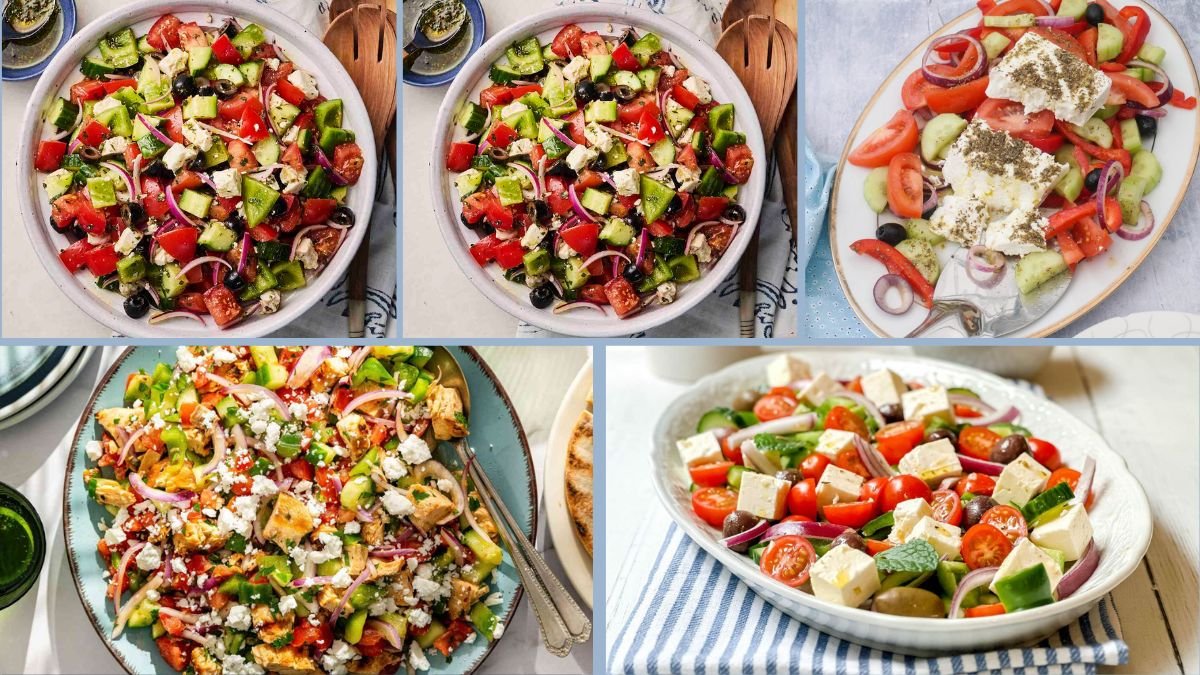Fresh, vibrant, and full of flavor, the Greek salad—or Horiatiki salata—is a timeless dish that captures the essence of the Mediterranean. With its simple combination of crisp vegetables, creamy feta, briny olives, and a drizzle of olive oil, it’s a perfect example of how basic ingredients, when treated with care, can create something truly delicious.
While many variations of Greek salad exist, the classic version is naturally vegetarian (though not vegan, due to the cheese) and requires no meat or seafood. It’s also quick to prepare, making it ideal for busy weekdays, light lunches, or warm summer evenings.
In this article, we’ll walk you through 7 essential steps to crafting an authentic, classic Greek salad—in just minutes and entirely without non-vegetarian ingredients. No shortcuts, no meat, no anchovies—just the real taste of Greece.
Step 1: Choose the Right Tomatoes
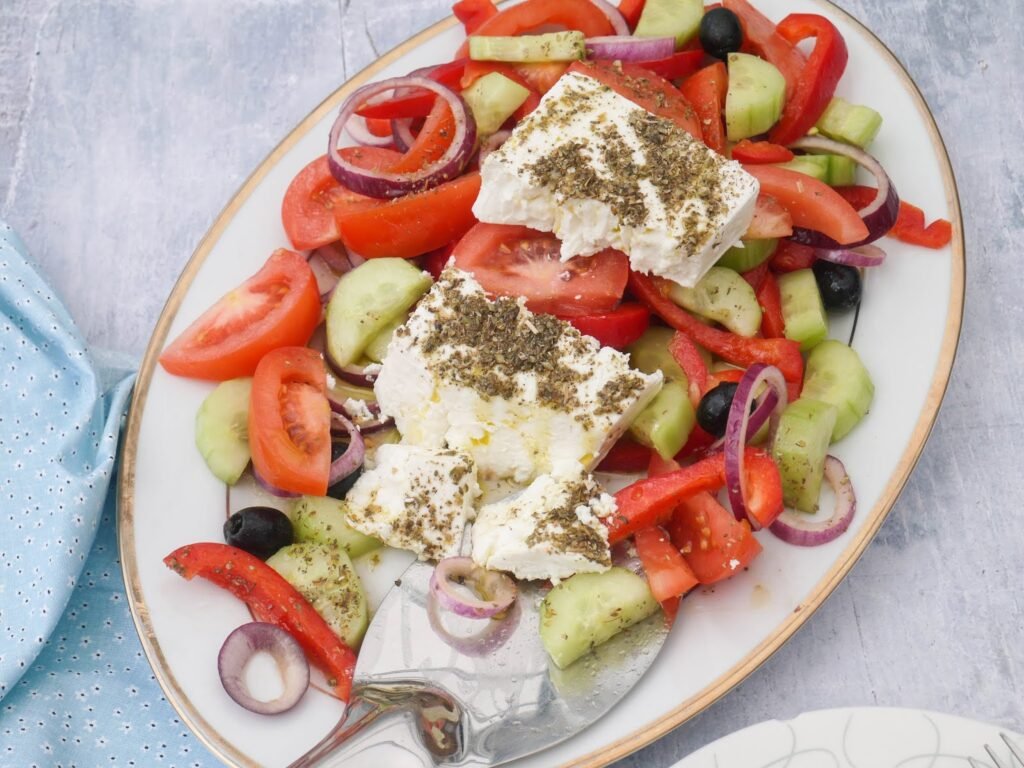
Tomatoes are the foundation of a good Greek salad. They provide the juicy sweetness and acidity that balance the saltiness of the olives and feta.
How to Choose:
- Use ripe, juicy tomatoes—ideally vine-ripened or heirloom varieties.
- Cherry tomatoes can be used if you’re in a hurry or out of season.
- Look for tomatoes with a deep red color and a fragrant aroma.
Prep Tips:
- Cut large tomatoes into irregular chunks, not thin slices. The rustic texture helps trap the dressing.
- If using cherry tomatoes, halve them for better absorption of flavors.
Why it matters: Overripe or under-flavored tomatoes will flatten the dish. Choose ripe, room-temperature tomatoes for best taste.
Step 2: Use Crisp, Fresh Cucumbers
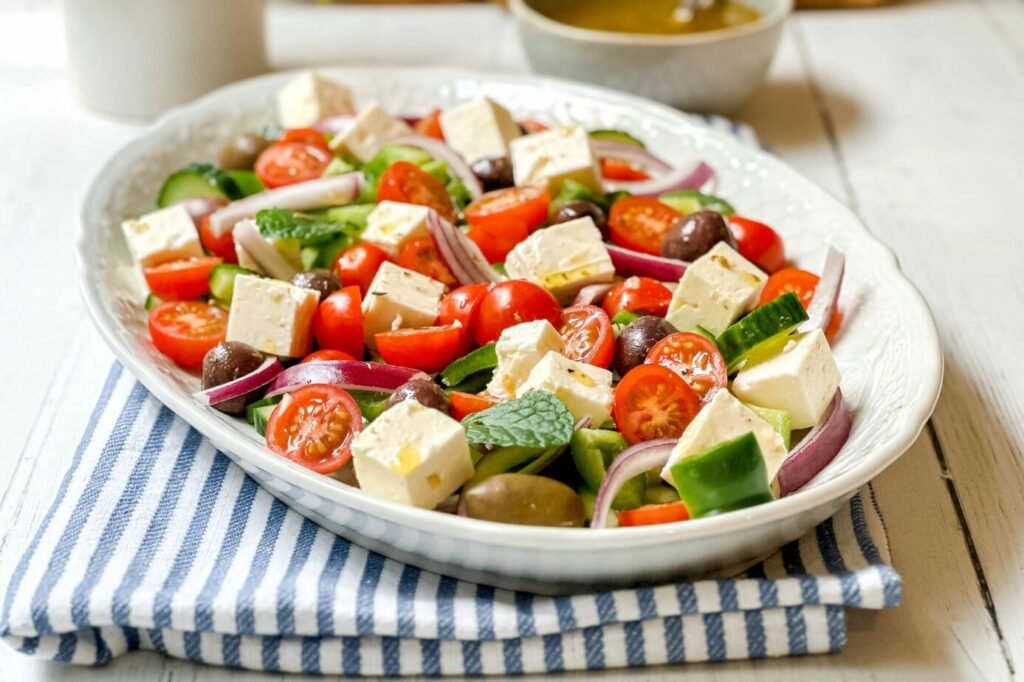
The crunch factor in a Greek salad comes from cucumbers. They should be cool, crisp, and slightly sweet.
Tips for Cucumber Selection:
- Use English cucumbers or Persian cucumbers—they’re seedless and less bitter.
- If using regular cucumbers, remove large seeds to prevent watery results.
- Peeling is optional; leave some skin for added texture and color.
Prep Tip:
- Cut cucumbers into thick half-moons or chunks rather than thin slices to match the rustic style.
Why it matters: Cucumbers add freshness and crunch. Cutting them right prevents sogginess and enhances texture.
Step 3: Add Red Onion for Bite and Balance
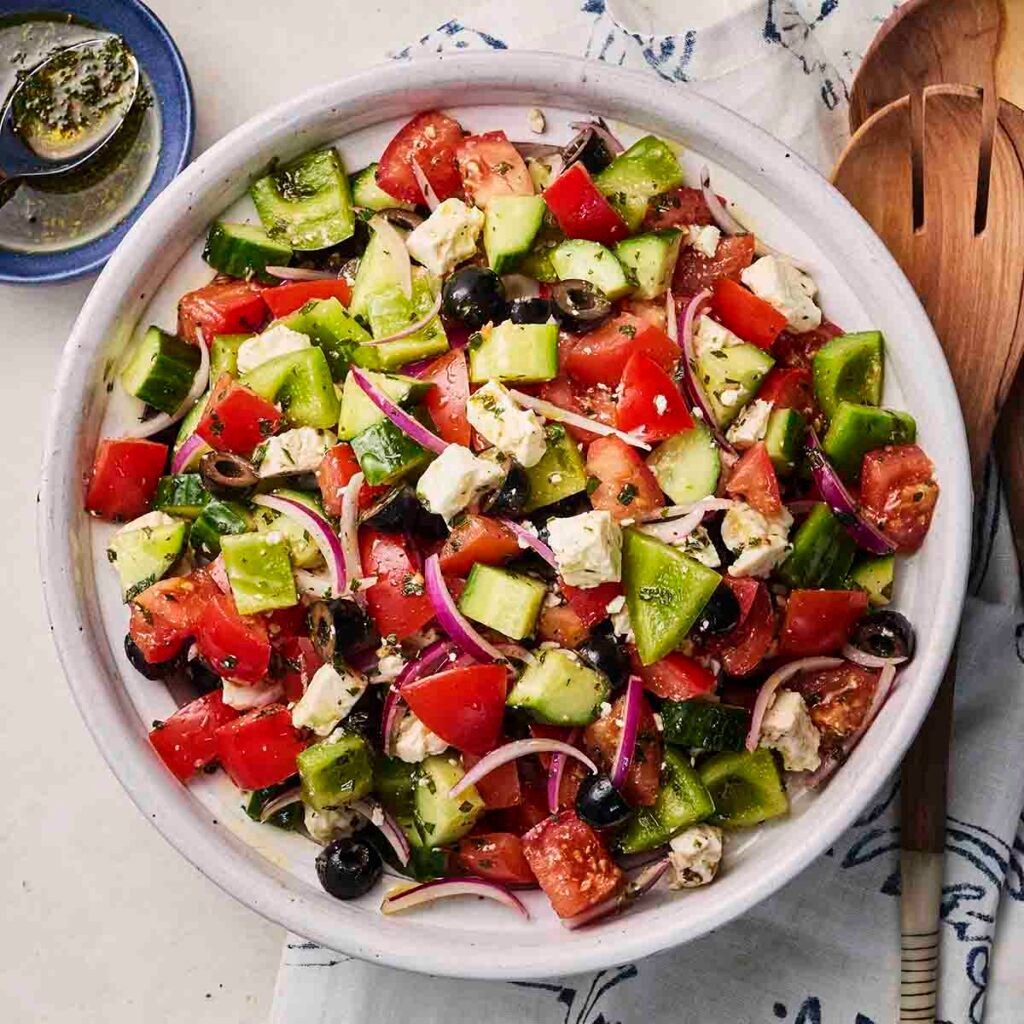
Red onions bring sharpness and aroma to the salad, providing a contrast to the milder vegetables and cheese.
How to Prepare:
- Peel and slice thinly into rings or half-moons.
- For a milder flavor, soak the slices in ice water or lemon juice for 10–15 minutes before adding them to the salad.
This step helps tone down the pungency while keeping the onion’s crunch.
Why it matters: Raw onion enhances the complexity of flavors but should be handled carefully to avoid overpowering the dish.
Step 4: Use Authentic Kalamata Olives

Kalamata olives are the soul of Greek salad. Their rich, briny flavor and deep purple color add both depth and visual appeal.
Choosing the Best Olives:
- Look for pitted Kalamata olives, preferably packed in brine (not canned in water).
- Avoid generic black olives—they lack the depth and richness of authentic Greek varieties.
Prep Tip:
- Slice in half or leave whole depending on texture preference.
- Rinse lightly if too salty, but avoid removing all the brine—it adds flavor.
Why it matters: High-quality olives provide contrast and salty complexity. Don’t skimp here—cheap olives can ruin the balance.
Step 5: Select the Right Feta Cheese
Traditional Greek salad is topped with a block of feta, not crumbled cheese. Feta adds creaminess, saltiness, and tang.
Choosing Vegetarian Feta:
- Look for feta made with vegetarian-friendly rennet (check the label).
- Use Greek feta made from sheep’s milk or a blend with goat’s milk for authenticity.
- Avoid overly dry or pre-crumbled feta; it lacks creaminess and can be overly salty.
Serving Tip:
- Cut into thick slices or large chunks and lay gently on top of the salad.
- Drizzle olive oil and sprinkle oregano directly on the cheese for extra flavor.
Why it matters: Feta should be creamy and briny, not rubbery or bland. It’s one of the defining flavors of the dish.
Step 6: Dress Simply but Generously
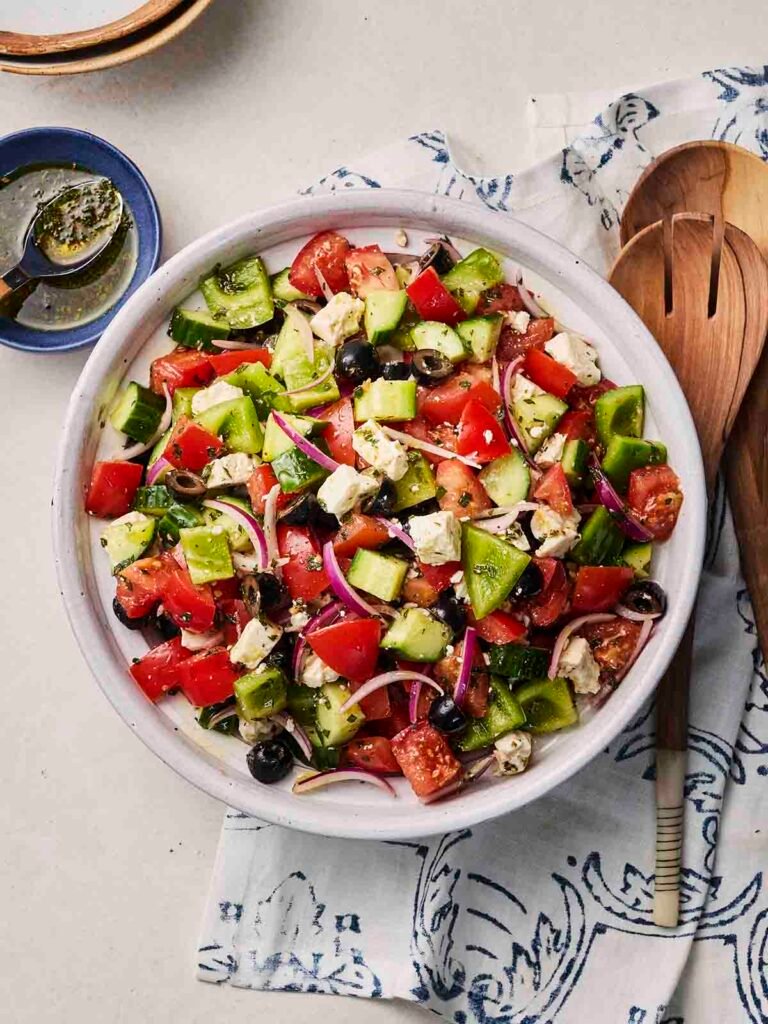
Greek salad dressing is not a bottled concoction—it’s a simple combination of extra virgin olive oil, acid, and herbs.
Classic Greek Salad Dressing:
- 3 tbsp extra virgin olive oil
- 1 tbsp red wine vinegar or lemon juice
- 1 tsp dried oregano
- Salt and black pepper, to taste
You can also add a pinch of dijon mustard or minced garlic for extra zing.
Application:
- Whisk the dressing and drizzle generously over the vegetables just before serving.
- Avoid over-mixing; let the vegetables remain layered and rustic.
Why it matters: The dressing is light and lets the ingredients shine. A well-balanced dressing ties all the elements together without overpowering them.
Step 7: Garnish and Serve with Confidence
Presentation and timing make a difference. Greek salad should look vibrant and rustic, not overly arranged or soggy.
Serving Tips:
- Serve immediately after dressing to maintain crunch.
- Garnish with:
- A sprinkle of dried oregano
- Extra olive oil drizzle
- Optional: a lemon wedge or fresh herbs like parsley or dill
Serve in a wide, shallow bowl for an authentic Mediterranean feel.
Why it matters: A good Greek salad is a feast for the eyes as well as the taste buds. Keeping it rustic but vibrant preserves the dish’s charm.
Sample Recipe: Classic Vegetarian Greek Salad
Ingredients:
- 3 ripe tomatoes, cut into chunks
- 1 large cucumber, halved and sliced
- ½ red onion, thinly sliced
- ½ cup Kalamata olives
- 150g vegetarian feta, cut into large slices
- 3 tbsp extra virgin olive oil
- 1 tbsp red wine vinegar
- 1 tsp dried oregano
- Salt and pepper to taste
Instructions:
- Combine tomatoes, cucumber, red onion, and olives in a large mixing bowl.
- Lay feta slices on top of the salad.
- Whisk together olive oil, vinegar, oregano, salt, and pepper.
- Drizzle dressing over salad just before serving.
- Garnish with extra oregano or herbs as desired.
- Serve immediately with crusty bread or grilled pita.
Optional Additions (All Vegetarian):
While the classic version is minimalist, you can customize the salad based on seasonal availability or dietary preferences:
- Bell peppers (green or red) for sweetness and crunch
- Capers for added brininess
- Avocado for creaminess
- Chickpeas for protein
- Tofu feta or nut-based cheese for vegan alternatives
Note: Always maintain the balance of salty, tangy, and fresh when adding ingredients.
Conclusion: Simplicity is the Secret
The beauty of a Greek salad lies in its simplicity and balance. With just a few ingredients, each chosen and prepared with care, you can create a dish that is refreshing, satisfying, and packed with authentic Mediterranean flavor.
By following these 7 essential steps—choosing ripe produce, using real Kalamata olives, selecting vegetarian feta, and dressing thoughtfully—you can recreate the magic of the Greek countryside on your plate in minutes. No meat, no anchovies, no shortcuts—just honest ingredients, big flavors, and timeless tradition.
